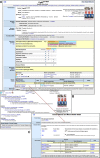The Mammalian Phenotype Ontology as a unifying standard for experimental and high-throughput phenotyping data
- PMID: 22961259
- PMCID: PMC3463787
- DOI: 10.1007/s00335-012-9421-3
The Mammalian Phenotype Ontology as a unifying standard for experimental and high-throughput phenotyping data
Abstract
The Mammalian Phenotype Ontology (MP) is a structured vocabulary for describing mammalian phenotypes and serves as a critical tool for efficient annotation and comprehensive retrieval of phenotype data. Importantly, the ontology contains broad and specific terms, facilitating annotation of data from initial observations or screens and detailed data from subsequent experimental research. Using the ontology structure, data are retrieved inclusively, i.e., data annotated to chosen terms and to terms subordinate in the hierarchy. Thus, searching for "abnormal craniofacial morphology" also returns annotations to "megacephaly" and "microcephaly," more specific terms in the hierarchy path. The development and refinement of the MP is ongoing, with new terms and modifications to its organization undergoing continuous assessment as users and expert reviewers propose expansions and revisions. A wealth of phenotype data on mouse mutations and variants annotated to the MP already exists in the Mouse Genome Informatics database. These data, along with data curated to the MP by many mouse mutagenesis programs and mouse repositories, provide a platform for comparative analyses and correlative discoveries. The MP provides a standard underpinning to mouse phenotype descriptions for existing and future experimental and large-scale phenotyping projects. In this review we describe the MP as it presently exists, its application to phenotype annotations, the relationship of the MP to other ontologies, and the integration of the MP within large-scale phenotyping projects. Finally we discuss future application of the MP in providing standard descriptors of the phenotype pipeline test results from the International Mouse Phenotype Consortium projects.
Figures



References
-
- Araki K, Imaizumi T, Sekimoto T, Yoshinobu K, Yoshimuta J, Akizuki M, Miura K, Araki M, Yamamura K. Exchangeable gene trap using the Cre/mutated lox system. Cell Mol Biol (Noisy-le-grand) 1999;45:737–750. - PubMed
Publication types
MeSH terms
Grants and funding
LinkOut - more resources
Full Text Sources
Other Literature Sources
Molecular Biology Databases

